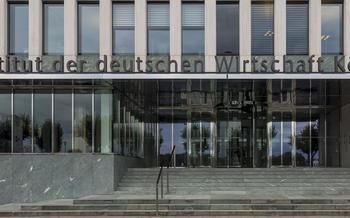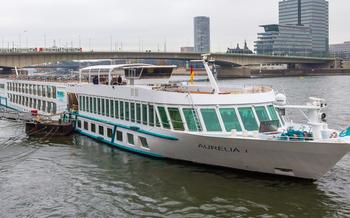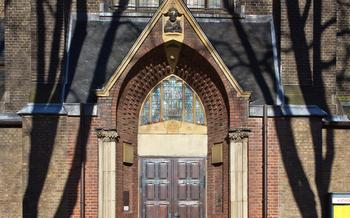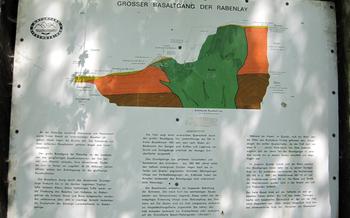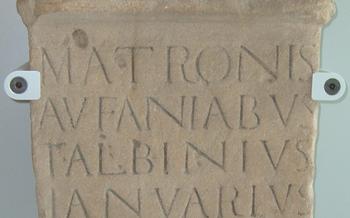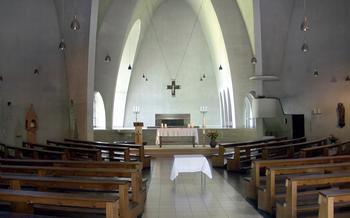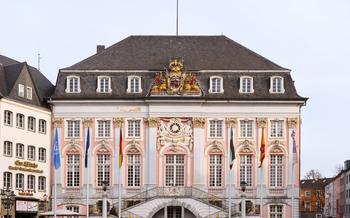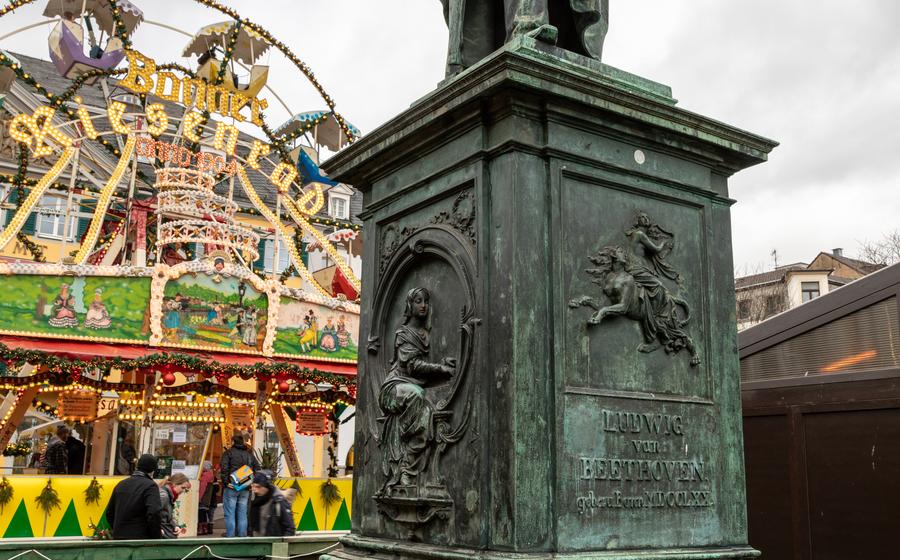
Münster Square (Münsterplatz)
- Münsterplatz: A Historic Centerpiece
- Münster Cathedral: A Symbol of Bonn's Past
- Beethoven Monument: A Tribute to a Musical Genius
- Old Town Hall: A Seat of Local Government
- Marktbrunnen: A Symbol of Trade and Commerce
- Kurfürstliches Schloss: A Palace with a Rich History
- Hofgarten: A Tranquil Oasis in the City Center
- Fransizkanerstraße: A Charming Pedestrian Zone
- Haus der Geschichte der Bundesrepublik Deutschland: A Journey Through German History
- August-Macke-Haus: A Celebration of Expressionism
- Rheinisches Landesmuseum: A Treasure Trove of Regional History
- Kunstmuseum Bonn: A Showcase of Modern and Contemporary Art
- Insider Tip: Exploring Bonn's Hidden Gems
Münsterplatz: A Historic Centerpiece
Münsterplatz, the heart of Bonn's historic city center, has witnessed centuries of history and cultural significance. This vibrant square is surrounded by architectural marvels that tell the story of Bonn's rich past. The centerpiece of the square is the majestic Münster Cathedral, a symbol of the city's religious heritage. To the south of the cathedral stands the Old Town Hall, a testament to Bonn's civic pride and local government traditions. The Marktbrunnen, a beautiful fountain, stands in the center of the square, representing the city's bustling market activities.
The square is also home to the Alte Universität, a former university building that now houses the University of Bonn's administrative offices. The Kurfürstliches Schloss, a grand electoral palace, adds to the square's regal charm. Surrounding the square are charming cafes, restaurants, and shops, inviting visitors to soak in the historic ambiance while enjoying the city's vibrant atmosphere.
Münster Cathedral: A Symbol of Bonn's Past
The Münster Cathedral, officially known as the Cathedral of Ss. Cassius and Florentius, stands as a testament to Bonn's rich history and enduring faith. Constructed in the Romanesque style, the cathedral's origins date back to the 11th century, with subsequent additions and modifications over the centuries. Its imposing facade, adorned with intricate carvings and sculptures, immediately captures the attention of visitors.
Stepping inside the cathedral, one is struck by the awe-inspiring grandeur of its interior. The nave, with its soaring columns and vaulted ceiling, creates a sense of spaciousness and reverence. The stained-glass windows, crafted by renowned artists, depict biblical scenes and illuminate the cathedral with vibrant colors. Among the notable features of the interior is the Kreuzigungsgruppe, a poignant wooden sculpture depicting the crucifixion of Jesus Christ. Created in the 13th century, this masterpiece is considered one of the most significant works of art in the cathedral.
Beyond its architectural and artistic significance, the Münster Cathedral holds a deep spiritual and cultural connection to Bonn. Over the centuries, the cathedral has served as a place of worship, pilgrimage, and religious ceremonies. It has witnessed countless baptisms, weddings, and funerals, becoming an integral part of the lives of Bonn's citizens. The cathedral also played a pivotal role in Bonn's history as the seat of the Archbishopric of Cologne, further solidifying its position as a symbol of the city's rich past.
Beethoven Monument: A Tribute to a Musical Genius
Ludwig van Beethoven, one of the world's most renowned composers, was born in Bonn in 1770. The city pays homage to its illustrious son with the Beethoven Monument, a majestic tribute that stands proudly in Münsterplatz. Unveiled in 1845, the monument was designed by the sculptor Ernst Julius Hähnel and is considered a masterpiece of neoclassical art.
The monument depicts Beethoven seated in a chair, his head slightly tilted to the side as if listening to the music in his mind. His right hand rests on a musical score, while his left hand gracefully holds a quill pen. The bronze statue is perched atop a pedestal adorned with reliefs depicting scenes from Beethoven's life and works.
The creation of the Beethoven Monument was a labor of love for the citizens of Bonn. They raised funds through public donations and commissioned Hähnel to bring their vision to life. The monument's unveiling was a grand occasion, attended by dignitaries, musicians, and art enthusiasts from across Europe.
Today, the Beethoven Monument stands as a symbol of Bonn's deep connection to its musical heritage. It is a popular gathering place for locals and tourists alike, who come to pay their respects to the great composer and admire the exquisite craftsmanship of the monument.
Old Town Hall: A Seat of Local Government
Bonn's Old Town Hall, proudly standing on the bustling Münsterplatz, is a magnificent testament to the city's rich history and civic pride. Constructed in the 18th century, this imposing Baroque structure has served as the seat of local government for centuries, witnessing countless crucial decisions and events that have shaped Bonn's destiny.
The Old Town Hall's architectural grandeur is evident in its intricate facade, adorned with elegant pilasters, ornate carvings, and a sweeping central staircase. The building's exterior reflects the prevailing architectural styles of its time, blending Baroque elements with classical influences. Inside, visitors are greeted by a grand entrance hall, leading to a series of impressive chambers and offices, each adorned with unique decorative touches.
As the heart of Bonn's local government, the Old Town Hall has played a pivotal role in the city's political and administrative affairs. Within its walls, countless meetings, debates, and decisions have taken place, shaping the course of Bonn's development. Notable events associated with the town hall include the signing of the Bonn Agreement in 1949, which established the Federal Republic of Germany, and the city's selection as the provisional capital of West Germany from 1949 to 1990.
Today, the Old Town Hall continues to serve as a functional seat of local government, housing various administrative departments and the office of the mayor. Visitors can admire the building's grandeur from afar or take guided tours to explore its historic interiors, gaining insights into Bonn's rich political heritage.
Marktbrunnen: A Symbol of Trade and Commerce
In the heart of Münsterplatz stands the Marktbrunnen, a magnificent fountain that has become an iconic symbol of Bonn's rich history and its vibrant market culture. Constructed in 1777 by the renowned court sculptor Johann Joseph Imhoff, the fountain stands as a testament to the city's flourishing trade and commerce during the 18th century.
The fountain's design is a masterful blend of Baroque and Rococo elements, featuring an elaborate basin adorned with intricate carvings and sculptures. At the center of the fountain, a majestic figure of Atlas, the mythical Greek Titan, stands atop a pedestal, supporting a globe on his shoulders. This striking representation symbolizes the city's global trading connections and its role as a center of commerce in the Rhineland region.
Throughout history, the Marktbrunnen has served as a gathering place for merchants, traders, and shoppers, who would congregate around the fountain to conduct business and exchange goods. The fountain's location in the heart of the city's market square further underscores its significance as a symbol of trade and commerce.
Beyond its historical and cultural importance, the Marktbrunnen is also a beloved landmark for locals and visitors alike. Its graceful silhouette and intricate details make it a popular spot for photography and a favorite meeting point for friends and families. The fountain's constant flow of water creates a tranquil ambiance, adding to the charm and vibrancy of Münsterplatz.
Kurfürstliches Schloss: A Palace with a Rich History
Bonn's electoral palace, the Kurfürstliches Schloss, stands as a testament to the city's rich history and architectural heritage. Built in the 18th century, this imposing palace served as the residence of the prince-electors of Cologne, who ruled over the region for centuries.
The palace is a magnificent example of Baroque architecture, with its grand façade, elegant symmetry, and intricate ornamentation. Its stately exterior is complemented by a lavish interior, featuring opulent state rooms, grand staircases, and exquisitely decorated halls.
Today, the Kurfürstliches Schloss serves as the official seat of the University of Bonn, housing various academic departments and administrative offices. Despite its transformation into a modern educational institution, the palace retains its historical charm and remains a beloved landmark for both students and visitors alike.
The palace is open to the public for guided tours, offering a glimpse into its rich history and architectural splendor. Visitors can admire the grand halls, marvel at the intricate artwork, and learn about the significant role the palace played in shaping Bonn's past.
Hofgarten: A Tranquil Oasis in the City Center
Amidst the bustling streets of Bonn, the Hofgarten offers a tranquil retreat for locals and visitors alike. This serene garden, established in the 18th century, is a testament to the city's rich history and love for nature. Designed in the French Baroque style, the Hofgarten boasts meticulously manicured lawns, vibrant flower beds, and towering trees that create a picturesque setting for leisurely strolls and quiet contemplation.
Notable features of the garden include the Poppelsdorfer Allee, a majestic avenue of poplar trees that leads to the Poppelsdorf Palace, and the Venus Fountain, an elegant fountain adorned with a statue of the Roman goddess Venus. Visitors can also admire the variety of sculptures scattered throughout the garden, each telling a unique story about Bonn's past.
The Hofgarten is not just a place of beauty but also a hub of cultural and educational activities. It hosts concerts, exhibitions, and workshops throughout the year, attracting a diverse crowd of art enthusiasts, nature lovers, and families. The garden is also home to the University of Bonn's Botanical Garden, which boasts a vast collection of plants from around the world, making it a popular destination for students and researchers alike.
Whether you seek a peaceful retreat from the city's hustle and bustle, a place to admire nature's beauty, or a venue for cultural enrichment, the Hofgarten is an oasis that caters to all. Take a leisurely stroll along its paths, relax on a bench beneath the shade of a tree, or enjoy a picnic with friends and family in this idyllic setting. The Hofgarten is a true gem in Bonn, offering a sanctuary of tranquility and a glimpse into the city's rich cultural heritage.
Fransizkanerstraße: A Charming Pedestrian Zone
Franziskanerstraße is a vibrant pedestrian zone located in the heart of Bonn's historic center. Its name derives from the Franciscan monastery that once stood in the area, leaving behind a rich cultural and architectural legacy. The street is characterized by its narrow cobblestone lanes, colorful facades, and a lively atmosphere that attracts both locals and tourists alike.
Strolling along Franziskanerstraße, visitors can admire a diverse array of architectural styles, from medieval half-timbered houses to elegant Baroque buildings. One of the most striking structures is the Alte Post, a former post office built in the early 18th century. Today, it houses a charming café where visitors can relax and soak up the historic ambiance.
Franziskanerstraße is a shopper's paradise, offering a wide range of boutiques, specialty shops, and art galleries. Visitors can find everything from unique handicrafts and souvenirs to designer clothing and jewelry. The street is also home to several cozy cafés, restaurants, and bars, providing plenty of opportunities to savor delicious local cuisine and unwind amidst the lively atmosphere.
In addition to its shopping and dining options, Franziskanerstraße is also a hub for cultural events and exhibitions. Throughout the year, the street hosts art shows, concerts, and festivals, showcasing the vibrant cultural scene of Bonn. Whether you're looking for a leisurely stroll, a shopping spree, or a cultural immersion, Franziskanerstraße has something to offer everyone.
Insider Tip: For a unique souvenir, visit the Papierladen, a charming stationery shop that specializes in handmade papers and unique writing instruments.
Haus der Geschichte der Bundesrepublik Deutschland: A Journey Through German History
History and Significance
The Haus der Geschichte der Bundesrepublik Deutschland (House of the History of the Federal Republic of Germany) is a museum dedicated to the history of Germany from 1945 to the present. It is located in Bonn, the former capital of West Germany, and was founded in 1987 to commemorate the 40th anniversary of the Federal Republic of Germany. The museum's mission is to provide a comprehensive and objective account of German history during this period, and to promote understanding of the country's political, social, and cultural development.
Exhibits and Displays
The museum's permanent exhibition is divided into four sections, each covering a different period of German history:
The Post-War Era: This section explores the challenges faced by Germany in the aftermath of World War II, including the division of the country, the establishment of the Federal Republic of Germany, and the economic miracle of the 1950s.
The Cold War: This section examines the impact of the Cold War on Germany, including the Berlin Wall, the arms race, and the student protests of the 1960s.
Reunification and Beyond: This section covers the reunification of Germany in 1990, the challenges of integrating East and West Germany, and the country's role in Europe and the world in the 21st century.
Interactive Experiences and Educational Programs
The museum offers a variety of interactive experiences and educational programs to enhance visitors' understanding of German history. These include:
-
Multi-media exhibits: The museum uses a variety of multi-media exhibits to bring history to life, including films, photographs, and sound recordings.
-
Interactive displays: Visitors can interact with touchscreens and other devices to explore historical documents, maps, and timelines.
-
Educational programs: The museum offers a variety of educational programs for school groups and adult learners, including guided tours, workshops, and lectures.
August-Macke-Haus: A Celebration of Expressionism
The August-Macke-Haus is a museum dedicated to the life and work of August Macke, a prominent German Expressionist painter. Located in Bonn, the museum is housed in a beautiful villa that was once the artist's home. Visitors can explore a collection of Macke's paintings, watercolors, and drawings, as well as works by other Expressionist artists such as Franz Marc, Erich Heckel, and Emil Nolde. The museum also hosts temporary exhibitions and educational programs focused on Expressionism, providing a deeper understanding of this influential art movement.
Rheinisches Landesmuseum: A Treasure Trove of Regional History
The Rheinisches Landesmuseum (Rhineland State Museum) is a must-visit for anyone interested in the rich history and culture of the Rhineland region. Founded in 1820, the museum houses a vast collection of artifacts and exhibits that tell the story of the region from prehistoric times to the present day.
The museum's exhibits are divided into several sections, each focusing on a different aspect of Rhineland history. The prehistoric section features artifacts from the Stone Age and Bronze Age, including tools, weapons, and pottery. The Roman section showcases the region's Roman heritage, with exhibits on Roman architecture, mosaics, and coins. The medieval section explores the Middle Ages in the Rhineland, with displays on castles, monasteries, and trade.
In addition to its permanent exhibits, the Rheinisches Landesmuseum also hosts temporary exhibitions on various topics related to Rhineland history and culture. The museum also offers a variety of educational programs and guided tours for visitors of all ages.
Whether you're interested in learning more about the region's ancient past, its Roman heritage, or its medieval history, the Rheinisches Landesmuseum is the perfect place to start your exploration.
Kunstmuseum Bonn: A Showcase of Modern and Contemporary Art
The Kunstmuseum Bonn is a renowned institution dedicated to showcasing modern and contemporary art from around the world. Founded in 1947, the museum has a rich history of collecting and exhibiting works from the post-war era to the present day.
The museum's impressive collection features a diverse range of artistic styles and movements, including Expressionism, Cubism, Surrealism, and Pop Art. Visitors can explore masterworks by renowned artists such as Pablo Picasso, Wassily Kandinsky, Andy Warhol, and Joseph Beuys.
The Kunstmuseum Bonn not only houses a permanent collection but also hosts temporary exhibitions that showcase the latest trends and developments in contemporary art. These exhibitions often feature emerging artists and explore thought-provoking themes and concepts.
The museum's commitment to education and outreach programs makes it a vibrant hub for art enthusiasts and learners of all ages. Guided tours, workshops, and lectures are regularly organized to provide visitors with deeper insights into the artworks and the history of modern and contemporary art.
Whether you are an art aficionado or simply looking for a unique and inspiring experience, the Kunstmuseum Bonn is a must-visit destination. Its diverse collection and engaging exhibitions offer a captivating journey through the world of modern and contemporary art.
Insider Tip: Exploring Bonn's Hidden Gems
While the main attractions in Bonn offer a glimpse into the city's rich history and culture, there are many hidden gems waiting to be discovered. For a unique and off-the-beaten-path experience, visitors can explore the following:
-
Alter Friedhof (Old Cemetery): Located near the Rhine River, this historic cemetery is a tranquil oasis filled with ornate tombstones and sculptures, offering a glimpse into Bonn's past.
-
Rheinaue Park: This sprawling park on the banks of the Rhine River offers a variety of activities, including hiking trails, playgrounds, and a rose garden. It's a popular spot for locals and visitors alike to relax and enjoy the outdoors.
-
Hausdorff Center for Mathematics: This research center is home to a collection of mathematical models and exhibits, providing a fascinating insight into the world of mathematics. Guided tours are available for visitors interested in learning more.
-
Venusberg Observatory: Located on the Venusberg hill, this observatory offers stunning views of Bonn and the surrounding area. Visitors can explore the exhibits on astronomy and attend stargazing events.
-
Beethovenhalle: This concert hall is a hidden gem for music lovers. It hosts a variety of concerts and performances throughout the year, featuring both classical and contemporary music.
